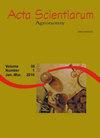Weed interference in melon crop under semi-arid conditions
IF 1.2
4区 农林科学
Q3 AGRONOMY
引用次数: 0
Abstract
The management of weeds in melon is hindered by the slow initial growth of the crop, favouring weed infestation and reducing production. During the years 2016 and 2017, weed interference periods were evaluated in two melon hybrids, yellow and frog skin, to determine the time of weed control in the crop. Four-parameter logistic regression was used to determine the critical weed control period (CPWC). The weed species with the highest occurrences in 2016 were Merremia aegyptia, Senna obtusifolia, and Urochloa plantaginea. In 2017, there was a predominance of M. aegyptia, indicating the possibility of successive cultivation, favouring the predominance of species with growth habits similar to melons. The increase in the period of living with weeds reduced the productivity and quality of melon fruits. Coexistence with weeds throughout the cycle reduced productivity by about 50%. The CPWC was 15 to 58 and 10 to 45 for frog skin and 12 to 52 and 4 to 50 days for yellow melon in 2016 and 2017, respectively, considering a productivity loss of 5%. These results underscore the importance of adopting strategies that allow melons to grow free from the presence of weeds, especially before they are fully established in the growing area.半干旱条件下瓜类作物杂草干扰研究
瓜类作物初期生长缓慢,有利于杂草侵扰,降低产量,阻碍了瓜类杂草的管理。2016年和2017年,对黄甜瓜和蛙皮甜瓜两个杂交品种的杂草干扰期进行了评估,以确定作物杂草控制的时间。采用四参数logistic回归法确定关键杂草控制期(CPWC)。2016年发生率最高的杂草品种为埃及细尾草、塞纳和车前草。2017年,埃及伊蚊占优势,表明有可能进行连续栽培,有利于生长习性与瓜类相似的物种占优势。杂草生存期的延长降低了甜瓜果实的产量和品质。在整个循环中与杂草共存会使生产力降低约50%。考虑到5%的生产力损失,2016年和2017年,青蛙皮的CPWC分别为15 ~ 58天和10 ~ 45天,黄瓜的CPWC分别为12 ~ 52天和4 ~ 50天。这些结果强调了采取策略的重要性,这些策略可以让瓜类在没有杂草的情况下生长,特别是在它们在种植区域完全建立之前。
本文章由计算机程序翻译,如有差异,请以英文原文为准。
求助全文
约1分钟内获得全文
求助全文
来源期刊

Acta Scientiarum. Agronomy.
Agricultural and Biological Sciences-Agronomy and Crop Science
CiteScore
2.40
自引率
0.00%
发文量
45
审稿时长
>12 weeks
期刊介绍:
The journal publishes original articles in all areas of Agronomy, including soil sciences, agricultural entomology, soil fertility and manuring, soil physics, physiology of cultivated plants, phytopathology, phyto-health, phytotechny, genesis, morphology and soil classification, management and conservation of soil, integrated management of plant pests, vegetal improvement, agricultural microbiology, agricultural parasitology, production and processing of seeds.
 求助内容:
求助内容: 应助结果提醒方式:
应助结果提醒方式:


